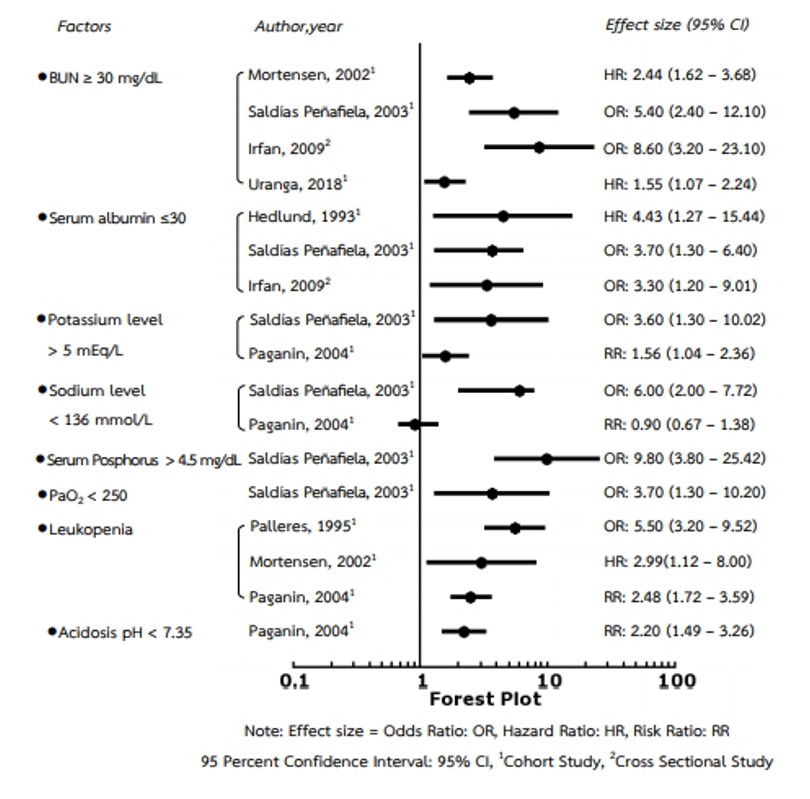Clinical Factors Associated with Mortality among Patients with Pneumonia: A Systematic Review
Keywords:
Pneumonia, Clinical Factors, Mortality, Systematic ReviewAbstract
Pneumonia is a respiratory infection that remains a medical and public health problem worldwide. Patients with pneumonia are at risk of death in case of lack of immediate and appropriate care. The purpose of this descriptive article is to systematically review clinical factors associated with mortality among patients with pneumonia. Research articles published in both national and international databases in the period between 1993 and 2018 were systematically reviewed. As a result, 16 articles from PubMed, Google Scholar, and ThaiJo were compatible with both the selection criteria and quality assessment. Results, in terms of clinical factors associated with mortality among patients with pneumonia, were determined by using effect size and 95% confidence interval (95%CI). They were then summarized and classified into 3 groups: 1) clinical factors of signs and symptoms, 2) clinical factors of laboratory testing, and 3) clinical factors of complications. Medical and health professionals who are responsible for treating patients with pneumonia should closely monitor those clinical factors, in order to prevent and reduce the risk factors associated with mortality among patients with pneumonia.
References
Chaimay, B. (2019). Public Health Research Methods. (4thed). Songkhla : Numsin Advertisement. (in Thai)
Chaiya, S. (2015). Annual Epidemiological Surveillance Report: Pneumnia. Nontaburi: Ministry of Public Health. (in Thai)
Department of Disease Control, Bureau of Epidemiology. (2019). Surveillance Database. Retrieved May 30, 2019 from https://apps.boe.moph.go.th/
Eurich, D. T., Marrie, T. J., Minhas-Sanhu, J. K., & Majumdar, S. R. (2015).Ten-Year Mortality After Community-Acquired Pneumonia. American Journal of Respiratory and Critical Care Medicine, 192(5), 597-604.
Fernández-Sabé, N., Carratala, J., Roson, B., Dorca, J., Verdaguer, R., Manresa, F., (2003). Community-Acquired Pneumonia in Very Elderly Patients Causative Organisms, Clinical Characteristics and Outcomes. Medicine, 82(3), 159-169.
Garcia-Vidal, C., Fernandez-Sabe, N., Caratala, J., Diaz, V., Verdaguer, R., Dorca, J. et al. (2008). Early Mortality in Patients with Community Acquired Pneumonia: Causes and Risk Factors. European Respiratory Journal, 32(3), 733-739.
Hedlund, J. U., Ortqvist, A. B., Kalin, M. E., & Granath, F. (1993). Factors of Importance for the Long Term Prognosis After Hospital Treated Pneumonia. Thorax, 48(1), 785-789.
Irfan, M., Hussain, S. F., Khubaib, M., Shafia, M., Mogri, M., Bana, M. et al. (2009). Community Acquired Pneumonia: Risk Factors Associated with Mortality in a Tertiary Care Hospitalized Patients. J Pak Med Assoc, 59(7), 448-452.
Kaplan, V., Agus, D. C., Griffin, M. F., Clerrmont, G., Watson, R. S., & Linde-Zwirble, W. T. (2002). Hospitalized Community-Acquired Pneumonia in the Elderly. Am J RespirCrit Care Med, 165(1), 766-772.
Linlawun, S. (2009). Clinical Features of Community-Acquired Pneumonia at Phrachomklao Hospital Petchaburi. Region 4-5 Medical Journal, 28(4), 413-422. (in Thai)
Mandell, L. A., Wunderink, R. G., Anzueto, A., Bartlett, J. G., Campbell G. D., Dean, N. C. et al. (2007). Infectious Diseases Society of America/American Thoracic Society Consensus Guidelines on the Management of Community-Acquired Pneumonia in Adults. Clin Infect, 44(2), 27-72.
Marston, B. J., Plouffe, J. F., File, T. M.,Hackman, B. A., Salstrom, S. J., Lipman, H. B. et al. (1997). Incidence of Community-Acquired Pneumonia Requiring Hospitalization: Results of a Population-Based Active Surveillance Study in Ohio. Arch Intern Med, 157(1), 1709-1718.
Mortensen, E. M., Coley, C. M., Singer, D. E., Marrie, T. J., Obrosky, D. S., Kapoor, W. N., & Fine, M. J. (2002). Causes of Death for Patients with Community-Acquired Pneumonia. American Medical Association, 162(1), 1059-1064.
National Institute for Emergency Medicine. (2014). Emergency Aeromedical Service Guideline Revision. Bangkok: Phanyamit Printing Company. (in Thai)
Paganin, F., Lilienthal, F., Bourdin, A., Lugagne, N., Tixier, F., Genin, R., & Yyin, J-L. (2004). Severe Community-Acquired Pneumonia: Assessment of Microbial Aetiology as Mortality Factor. European Respiratory Journal, 24(1), 779-785.
Palleres, R., Linares, J., Vadillo, M., Cabellos, C., Manresa, F., & Viladrich, P. F. (1995). Resistance to Penicilin and Cephalosporin and Mortality from Severe Pneumococcal Pneumonia in Baecelona, Spain. The New England Journal of Medicine, 333(8), 474-480.
Rattanaselanon, T. (2017). Clinical Aspects and Predictive Risk Factors for Mortality of Hospitalized Community-Acquired Pneumonia in U-thong Hospital: A Case-Control Study, Suphan Buri Province. Region 4-5 Medical Journal, 36(4), 291- 303. (in Thai)
Reechaipichitkul, W. (2015). Management of Pneumonia. KKU Journal of Medicine, 1(4), 17-29. (in Thai)
Roson, B., Caratala, J., Fernandez-Sabe, N., Tabau, F., Marresa, F., & Gudiol, F. (2004). Causes and Factors Associated With Early Failure in Hospitalized Patients With Community-Acquired Pneumonia. American Medical Association, 164(1), 502-508.
Sectish, T. C. & Prober, C. G. (2007). “Pneumonia. In Kliegman, R. M., Behrman, R. E., Jenson, H. B. & Stanton, B. F.” Nelson Textbook of Pediatrics. (pp. 1795-1799). Philadelphia: Saunders.
Sibunruang, S. (2019). Pneumococcus Infection and Prevention of Severe Infections in Adults and the Elderly. Bangkok: The Thai Red Cross Society. (in Thai)
Srivisai, T., & Onseng, V. (2017). Septic Shock: Challenges of Emergency Nurse. Boromarajonani College of Nursing, Uttaradit Journal, 9(2), 152-162. (in Thai)
Surasak, S., & Nathapol, S. (2014). Critical Appraisal for Health Research Articles. Naresuan Phayao Journal, 7(1), 286-297. (in Thai)
The Joanna Briggs Institute. (2017). Critical Appraisal Tools. Retrieved September 4, 2019 from http://joannabriggs.org /research/critical-appraisal-tools.html.
Torres, A., Ei-Ebiary, M., Zavala, E., & Hermandez, C. (1996). Severe Community-Acquired Pneumonia. Sem Respir Crit Care Med, 17(1), 265-71.
Udomkarnjananun, S. (2019). “Overview of the Causes and Treatment of Hyperphosphatemia. In Kawkitinarong, K., Suwanpimolku, K., Townamchai, N., Preuksapanich, P., Wattanachanya, L., Varachit, P. V.” Comprehensive Review in Internal Medicine. (pp. 319-326). Bangkok: Print & More Company. (in Thai)
Uranga, A., Quintana, J. M., Aguirre, U., Artaraz, A., Diez, R., Pascual, S. et al. (2018). Predicting 1-Year Mortality After Hospitalization for Community-Acquired Pneumonia. PLOS ONE, 13(2), 1-13.

Downloads
Published
Issue
Section
License
1. บทความหรือข้อคิดเห็นใด ๆ ที่ปรากฏในวารสารเครือข่าย วิทยาลัยพยาบาลและการสาธารณสุขภาคใต้ ที่เป็นวรรณกรรมของผู้เขียน บรรณาธิการหรือเครือข่ายวิทยาลัยพยาบาลและวิทยาลัยการสาธารณสุขภาคใต้ ไม่จำเป็นต้องเห็นด้วย
2. บทความที่ได้รับการตีพิมพ์ถือเป็นลิขสิทธิ์ของ วารสารเครือข่ายวิทยาลัยพยาบาลและการสาธารณสุขภาคใต้







